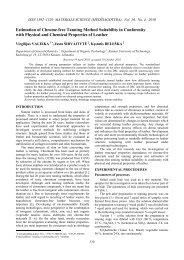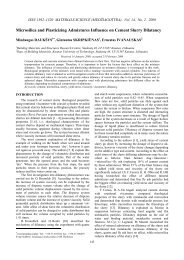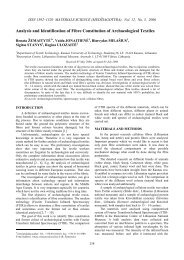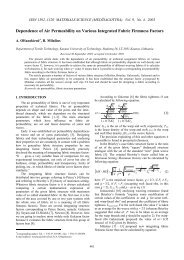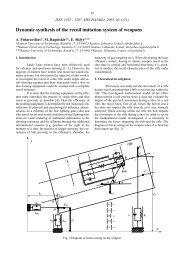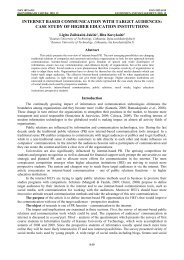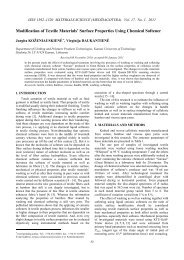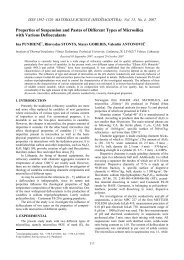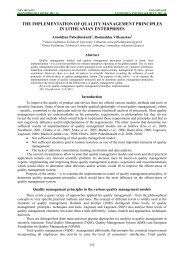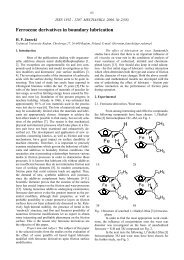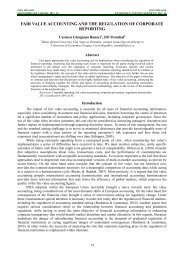Influence of strain rate on fracture of dispersion strengthened Al-AC ...
Influence of strain rate on fracture of dispersion strengthened Al-AC ...
Influence of strain rate on fracture of dispersion strengthened Al-AC ...
You also want an ePaper? Increase the reach of your titles
YUMPU automatically turns print PDFs into web optimized ePapers that Google loves.
ISSN 1392–1320 MATERIALS SCIENCE (MEDŽIAGOTYRA). Vol. 11, No. 3. 2005<br />
<str<strong>on</strong>g>Influence</str<strong>on</strong>g> <str<strong>on</strong>g>of</str<strong>on</strong>g> Strain Rate and Temperature <strong>on</strong> Mechanical Properties<br />
and Fracture Mechanism <str<strong>on</strong>g>of</str<strong>on</strong>g> Dispersi<strong>on</strong> Strengthened <strong>Al</strong>-12<strong>Al</strong> 4 C 3 System<br />
Olga VELGOSOVÁ 1∗ , Michael BESTERCI 2 , Priit KULU 3<br />
1 Technical University Faculty <str<strong>on</strong>g>of</str<strong>on</strong>g> Metallurgy, Department <str<strong>on</strong>g>of</str<strong>on</strong>g> N<strong>on</strong>-ferrous Materials and Waste Treatment,<br />
Letná 9/A, Košice 04200, Slovakia<br />
2 Institute <str<strong>on</strong>g>of</str<strong>on</strong>g> Materials Research, Slovak Academy <str<strong>on</strong>g>of</str<strong>on</strong>g> Sciences, Wats<strong>on</strong>ova 47, Košice 043 53, Slovakia<br />
3 Tallin University <str<strong>on</strong>g>of</str<strong>on</strong>g> Technology, Etritajate tee 5, 19086 Tallinn, Est<strong>on</strong>ia<br />
Received 27 May 2005; accepted 08 July 2005<br />
In the presented work the change in <strong>fracture</strong> for the <strong>Al</strong>-12<strong>Al</strong> 4 C 3 system was investigated and analysed at temperatures<br />
from 20 to 400 °C and <str<strong>on</strong>g>strain</str<strong>on</strong>g> <str<strong>on</strong>g>rate</str<strong>on</strong>g>s from 2.5·10 –5 to 10 –1 s –1 . At room temperature 20 °C, during tensile testing at <str<strong>on</strong>g>strain</str<strong>on</strong>g><br />
<str<strong>on</strong>g>rate</str<strong>on</strong>g>s in the tested regi<strong>on</strong>, the <str<strong>on</strong>g>strain</str<strong>on</strong>g> is first c<strong>on</strong>trolled by work hardening, expressed by the exp<strong>on</strong>ent n. In the sec<strong>on</strong>d<br />
generally smaller part the deformati<strong>on</strong> is limited by local <str<strong>on</strong>g>strain</str<strong>on</strong>g>ing and forming the neck. There is a marked decrease <str<strong>on</strong>g>of</str<strong>on</strong>g><br />
plastic properties for the <str<strong>on</strong>g>strain</str<strong>on</strong>g> <str<strong>on</strong>g>rate</str<strong>on</strong>g> ε& = 2.5·10 –5 s –1 with the growth <str<strong>on</strong>g>of</str<strong>on</strong>g> temperature in the investigated regi<strong>on</strong>. It is<br />
explained by changes in the micromechanism <str<strong>on</strong>g>of</str<strong>on</strong>g> deformati<strong>on</strong> and <strong>fracture</strong>. Fracture surface shows the transiti<strong>on</strong> from<br />
ductile <strong>fracture</strong> with dimples at 20 °C, to intercrystalline <strong>fracture</strong>s, with the growth <str<strong>on</strong>g>of</str<strong>on</strong>g> the temperature, an indicati<strong>on</strong> <str<strong>on</strong>g>of</str<strong>on</strong>g><br />
exhausted grain boundary plasticity. The intercrystalline <strong>fracture</strong> initiati<strong>on</strong> tends, it is supposed, to be localized in triple<br />
points. At temperatures 400 °C, and ε& = 10 –1 s –1 there is a marked growth <str<strong>on</strong>g>of</str<strong>on</strong>g> plastic properties. The first part <str<strong>on</strong>g>of</str<strong>on</strong>g> the<br />
<str<strong>on</strong>g>strain</str<strong>on</strong>g> characterized by work hardening is very short. After the short growth <str<strong>on</strong>g>of</str<strong>on</strong>g> the stress to maximum, a deformati<strong>on</strong><br />
mechanism, showing presence <str<strong>on</strong>g>of</str<strong>on</strong>g> thermally and mechanically activated dynamic recovery processes takes place. The<br />
<str<strong>on</strong>g>strain</str<strong>on</strong>g> is this way uniform all over the body <str<strong>on</strong>g>of</str<strong>on</strong>g> the test piece. The <strong>fracture</strong> process ends with the increase <str<strong>on</strong>g>of</str<strong>on</strong>g> cavities and<br />
transcrystalline <strong>fracture</strong> with deep pimples.<br />
Keywords: dispersi<strong>on</strong> <strong>strengthened</strong> materials, mechanical properties, <strong>fracture</strong> mechanism, TEM and SEM analysis.<br />
1. INTRODUCTION *<br />
The dispersi<strong>on</strong> <strong>strengthened</strong> alloys <strong>Al</strong>-<strong>Al</strong> 4 C 3 prepared<br />
by mechanical alloying using powder metallurgy<br />
technology are promising structural materials enabling<br />
significant cuts <str<strong>on</strong>g>of</str<strong>on</strong>g> weight for use first in aircraft and car<br />
industry, also at elevated temperatures [1 – 3]. We have<br />
described in work [4] the optimised producti<strong>on</strong> technology<br />
by mechanical alloying.<br />
In work [5] the mechanical properties and plasticity at<br />
elevated temperatures were analysed. In [6] the high<br />
temperature stability <str<strong>on</strong>g>of</str<strong>on</strong>g> this alloy is described for l<strong>on</strong>g time<br />
expositi<strong>on</strong>. In [7] the changes in microstructure were<br />
observed and analyzed after deformati<strong>on</strong> at elevated<br />
temperatures, and in [8] the mechanism <str<strong>on</strong>g>of</str<strong>on</strong>g> <strong>fracture</strong> in creep<br />
were studied.<br />
In [9, 10] was described the model <str<strong>on</strong>g>of</str<strong>on</strong>g> “in-situ” <strong>fracture</strong><br />
mechanism <str<strong>on</strong>g>of</str<strong>on</strong>g> these materials. Kinetics and mechanism <str<strong>on</strong>g>of</str<strong>on</strong>g><br />
superplastic deformati<strong>on</strong> <str<strong>on</strong>g>of</str<strong>on</strong>g> <strong>Al</strong> alloys are analyzed in<br />
works [11 – 16].<br />
In the present work we analyze the <strong>fracture</strong> at different<br />
<str<strong>on</strong>g>strain</str<strong>on</strong>g> <str<strong>on</strong>g>rate</str<strong>on</strong>g>s and temperature. Temperatures from 20 to<br />
400 °C and <str<strong>on</strong>g>strain</str<strong>on</strong>g> <str<strong>on</strong>g>rate</str<strong>on</strong>g>s from 2.5·10 –5 to 10 –1 s –1 had been<br />
used. C<strong>on</strong>sidering the results reported in [17] and the <str<strong>on</strong>g>strain</str<strong>on</strong>g><br />
induced coefficient m ranging from 0.03 to 0.06 we have<br />
covered the <str<strong>on</strong>g>strain</str<strong>on</strong>g> <str<strong>on</strong>g>rate</str<strong>on</strong>g>s from creep to the activati<strong>on</strong> <str<strong>on</strong>g>of</str<strong>on</strong>g><br />
superplastic behavior.<br />
* Corresp<strong>on</strong>ding author. Tel.: +421-55-6336401; fax.: +421-55-7922408.<br />
E-mail address: oksana.velgosova@tuke.sk (O. Velgosova)<br />
2. EXPERIMENTAL.<br />
MATERIAL AND METHODS<br />
The <strong>Al</strong>-<strong>Al</strong> 4 C 3 composite dispersi<strong>on</strong> <strong>strengthened</strong> by<br />
12 vol.% <str<strong>on</strong>g>of</str<strong>on</strong>g> <strong>Al</strong> 4 C 3 , has been prepared by the method <str<strong>on</strong>g>of</str<strong>on</strong>g><br />
mechanical alloying. The milling <str<strong>on</strong>g>of</str<strong>on</strong>g> the <strong>Al</strong> powder grain<br />
size under 100 µm with 1 % <str<strong>on</strong>g>of</str<strong>on</strong>g> KS 2.5 graphite lasted<br />
90 minutes. Granulate was compacted under the pressure<br />
<str<strong>on</strong>g>of</str<strong>on</strong>g> 600 MPa and annealed at 550°C with a 94 % reducti<strong>on</strong>.<br />
Fig. 1. Microstructure <str<strong>on</strong>g>of</str<strong>on</strong>g> <strong>Al</strong>-12<strong>Al</strong> 4 C 3 material<br />
The dispersed particles are oriented in layers in the<br />
directi<strong>on</strong> <str<strong>on</strong>g>of</str<strong>on</strong>g> extrusi<strong>on</strong>, Fig. 1. The effective size <str<strong>on</strong>g>of</str<strong>on</strong>g> the<br />
particles as measured <strong>on</strong> the foils was 25 × 85 nm. There<br />
217
were larger dispersed particles, too. They ranged from<br />
85 nm to 1 µm in size, making up about 30 % <str<strong>on</strong>g>of</str<strong>on</strong>g> dispersed<br />
amount, observed by Scanning Electr<strong>on</strong> Microscopy<br />
(SEM) and metallography. The <strong>Al</strong> 4 C 3 and <strong>Al</strong> 2 O 3 particles<br />
are <strong>on</strong> grain boundaries as well as inside in <strong>Al</strong> grains. The<br />
observed microstructure is fine, even, with grains less than<br />
1 µm, el<strong>on</strong>gated in the directi<strong>on</strong> <str<strong>on</strong>g>of</str<strong>on</strong>g> extrusi<strong>on</strong>, Fig. 2.<br />
disorientati<strong>on</strong>. There are small parts <str<strong>on</strong>g>of</str<strong>on</strong>g> <strong>fracture</strong> showing<br />
crests <str<strong>on</strong>g>of</str<strong>on</strong>g> ductile facets. For the <str<strong>on</strong>g>strain</str<strong>on</strong>g> <str<strong>on</strong>g>rate</str<strong>on</strong>g> ε& = 10 –1 s –1 the<br />
fracturing ended at a reducti<strong>on</strong> <str<strong>on</strong>g>of</str<strong>on</strong>g> area Z = 64 %. The<br />
<strong>fracture</strong> is ductile transcrystalline with developed deep<br />
dimples Fig. 7. The characteristic dimple dimensi<strong>on</strong> is<br />
0.65 µm.<br />
600<br />
500<br />
ε& = 10<br />
ε& = 10<br />
ε& = 2.5<br />
− 1 −1<br />
s<br />
− 3 −1<br />
s<br />
− 5 −1<br />
⋅10<br />
s<br />
80<br />
Rp0.2 [MPa]<br />
400<br />
300<br />
200<br />
100<br />
R p 0.2<br />
Z<br />
60<br />
Z [%]<br />
40<br />
20<br />
Fig. 2. The foil <str<strong>on</strong>g>of</str<strong>on</strong>g> <strong>Al</strong>-12<strong>Al</strong> 4 C 3 material<br />
Test pieces 3 mm in diameter and 15 mm gauge length<br />
had been machined for tensile test. They were positi<strong>on</strong>ed<br />
in l<strong>on</strong>gitudinal directi<strong>on</strong>, in respect to the directi<strong>on</strong> <str<strong>on</strong>g>of</str<strong>on</strong>g><br />
extrusi<strong>on</strong>. For the evaluati<strong>on</strong> <str<strong>on</strong>g>of</str<strong>on</strong>g> <str<strong>on</strong>g>strain</str<strong>on</strong>g> and <strong>fracture</strong><br />
mechanisms SEM examined <strong>fracture</strong> surfaces.<br />
3. RESULTS AND DISCUSSION<br />
The results are summarised in Fig. 3, where the yield<br />
strength R p 0.2 and the reducti<strong>on</strong> <str<strong>on</strong>g>of</str<strong>on</strong>g> area Z are plotted in<br />
dependence <strong>on</strong> the test temperature and <str<strong>on</strong>g>strain</str<strong>on</strong>g> <str<strong>on</strong>g>rate</str<strong>on</strong>g> applied.<br />
Note that by temperature 400 °C and <str<strong>on</strong>g>strain</str<strong>on</strong>g> <str<strong>on</strong>g>rate</str<strong>on</strong>g> 10 –1 s –1<br />
occur rapid increase in value Z but the value <str<strong>on</strong>g>of</str<strong>on</strong>g> yield<br />
strength d<strong>on</strong>’t remark the substantial changes. Corresp<strong>on</strong>ding<br />
results were obtained for UTS and el<strong>on</strong>gati<strong>on</strong>.<br />
For high <str<strong>on</strong>g>strain</str<strong>on</strong>g> <str<strong>on</strong>g>rate</str<strong>on</strong>g> ε& = 10<br />
–1 s –1 and temperature 20 °C<br />
the <strong>fracture</strong> surface is presented in Fig. 4. For low <str<strong>on</strong>g>strain</str<strong>on</strong>g><br />
<str<strong>on</strong>g>rate</str<strong>on</strong>g>s ε& = 2.5·10<br />
–5 s –1 it is in Fig. 5. There are no significant<br />
differences between them. Both are ductile, transcrystalline<br />
<strong>fracture</strong>s with dimples. The dimples are shallow with a<br />
characteristic dimensi<strong>on</strong> 0.45 µm.<br />
Fracture surfaces <strong>fracture</strong>d at <str<strong>on</strong>g>strain</str<strong>on</strong>g> <str<strong>on</strong>g>rate</str<strong>on</strong>g> ε& =2.5·10<br />
–5 s –1<br />
and temperature 300 °C showed underdeveloped intercrystalline<br />
facets. They are underdeveloped because at the end<br />
<str<strong>on</strong>g>of</str<strong>on</strong>g> <strong>fracture</strong>, a ductile <strong>fracture</strong> takes place. At the <str<strong>on</strong>g>strain</str<strong>on</strong>g> <str<strong>on</strong>g>rate</str<strong>on</strong>g><br />
ε& = 10<br />
–1 s –1 the <strong>fracture</strong> is transcrystalline with dimples.<br />
The dimples are deeper and larger then those at 20 °C. The<br />
characteristic dimple diameter is around 0.6 µm.<br />
At low <str<strong>on</strong>g>strain</str<strong>on</strong>g> <str<strong>on</strong>g>rate</str<strong>on</strong>g> ε& = 2.5·10 –5 s –1 and temperature<br />
400 °C the <strong>fracture</strong> took place at Z = 8 %. Typical micro<br />
facets <str<strong>on</strong>g>of</str<strong>on</strong>g> the <strong>fracture</strong> are shown in Fig. 6. Prevailingly,<br />
developed intercrystalline facets are present, with dimensi<strong>on</strong>s<br />
corresp<strong>on</strong>ding to the fine grain size, and great angle<br />
0<br />
0 100 200 300 400 500<br />
t [°C]<br />
Fig. 3. <str<strong>on</strong>g>Influence</str<strong>on</strong>g> <str<strong>on</strong>g>of</str<strong>on</strong>g> temperature and <str<strong>on</strong>g>strain</str<strong>on</strong>g> <str<strong>on</strong>g>rate</str<strong>on</strong>g> <strong>on</strong> yield strength<br />
R p 0.2 and reducti<strong>on</strong> <str<strong>on</strong>g>of</str<strong>on</strong>g> area Z<br />
Fig. 4. Transcrystalline <strong>fracture</strong> surface obtained with <str<strong>on</strong>g>strain</str<strong>on</strong>g> <str<strong>on</strong>g>rate</str<strong>on</strong>g><br />
10 –1 s –1 and temperature 20 °C<br />
The dependence the middle dimples diameter <str<strong>on</strong>g>of</str<strong>on</strong>g> temperature<br />
for <str<strong>on</strong>g>strain</str<strong>on</strong>g> <str<strong>on</strong>g>rate</str<strong>on</strong>g> 10 –1 s –1 is seen <strong>on</strong> Fig. 8. The analysis<br />
<str<strong>on</strong>g>of</str<strong>on</strong>g> <strong>fracture</strong> at 400 °C and <str<strong>on</strong>g>strain</str<strong>on</strong>g> <str<strong>on</strong>g>rate</str<strong>on</strong>g> ε& = 2.5·10<br />
–5 s –1<br />
has shown intercrystalline <strong>fracture</strong>s, as the result <str<strong>on</strong>g>of</str<strong>on</strong>g><br />
damage to grain boundaries formed by interacti<strong>on</strong>s <str<strong>on</strong>g>of</str<strong>on</strong>g><br />
dislocati<strong>on</strong>s with dispersed particles <strong>on</strong> grain boundaries.<br />
However, the fine particles <strong>on</strong> grain boundaries are<br />
0<br />
218
0.8<br />
0.6<br />
d d [ µm]<br />
0.4<br />
0.2<br />
0<br />
0 100 200 300 400<br />
t [°C]<br />
Fig. 5. Transcrystalline <strong>fracture</strong> surface obtained with <str<strong>on</strong>g>strain</str<strong>on</strong>g> <str<strong>on</strong>g>rate</str<strong>on</strong>g><br />
2.5·10 –5 s –1 and temperature 20 °C<br />
Fig. 6. Intercrystalline <strong>fracture</strong> surface obtained with <str<strong>on</strong>g>strain</str<strong>on</strong>g> <str<strong>on</strong>g>rate</str<strong>on</strong>g><br />
2.5·10 –5 s –1 and temperature 400 °C<br />
Fig. 8. The dependence <str<strong>on</strong>g>of</str<strong>on</strong>g> the middle dimple diameter <strong>on</strong><br />
temperature for <str<strong>on</strong>g>strain</str<strong>on</strong>g> <str<strong>on</strong>g>rate</str<strong>on</strong>g> 10 –1 s –1<br />
important for diffusi<strong>on</strong> creep and strength properties at<br />
high temperatures. Transcrystalline <strong>fracture</strong>s at high <str<strong>on</strong>g>strain</str<strong>on</strong>g><br />
<str<strong>on</strong>g>rate</str<strong>on</strong>g>s (10 –1 s –1 ) show a remarkable recovery in the plato<br />
part <str<strong>on</strong>g>of</str<strong>on</strong>g> the stress-<str<strong>on</strong>g>strain</str<strong>on</strong>g> curve, a dynamic polyg<strong>on</strong>isati<strong>on</strong><br />
resulting in a dynamic equilibrium <str<strong>on</strong>g>of</str<strong>on</strong>g> strengthening and<br />
weakening. The <strong>fracture</strong> is caused by voids occurring <strong>on</strong><br />
the interfaces dispersed-matrix first <strong>on</strong> larger particles,<br />
after a great amount <str<strong>on</strong>g>of</str<strong>on</strong>g> <str<strong>on</strong>g>strain</str<strong>on</strong>g>. The voids are growing and<br />
coalescence into dimples <str<strong>on</strong>g>of</str<strong>on</strong>g> the transcrystalline <strong>fracture</strong>.<br />
4. CONCLUSIONS<br />
At room temperature 20 °C, during tensile testing at<br />
<str<strong>on</strong>g>strain</str<strong>on</strong>g> <str<strong>on</strong>g>rate</str<strong>on</strong>g>s in the tested regi<strong>on</strong>, the <str<strong>on</strong>g>strain</str<strong>on</strong>g> is first c<strong>on</strong>trolled<br />
by work hardening, expressed by the exp<strong>on</strong>ent n. In the<br />
sec<strong>on</strong>d generally smaller part the deformati<strong>on</strong> is limited by<br />
local <str<strong>on</strong>g>strain</str<strong>on</strong>g>ing and forming the neck.<br />
There is a marked decrease <str<strong>on</strong>g>of</str<strong>on</strong>g> plastic properties for the<br />
<str<strong>on</strong>g>strain</str<strong>on</strong>g> <str<strong>on</strong>g>rate</str<strong>on</strong>g> ε& = 2.5·10 –5 s –1 with the growth <str<strong>on</strong>g>of</str<strong>on</strong>g> temperature<br />
in the investigated regi<strong>on</strong>. It is explained by changes in the<br />
micromechanism <str<strong>on</strong>g>of</str<strong>on</strong>g> deformati<strong>on</strong> and <strong>fracture</strong>. Fracture<br />
surface shows the transiti<strong>on</strong> from ductile <strong>fracture</strong> with<br />
dimples at 20 °C, to intercrystalline <strong>fracture</strong>s, with the<br />
growth <str<strong>on</strong>g>of</str<strong>on</strong>g> the temperature, an indicati<strong>on</strong> <str<strong>on</strong>g>of</str<strong>on</strong>g> exhausted grain<br />
boundary plasticity. The intercrystalline <strong>fracture</strong> initiati<strong>on</strong><br />
tends, it is supposed, to be localized in triple points.<br />
At temperatures 400 °C, and ε& = 10<br />
–1 s –1 there is a<br />
marked growth <str<strong>on</strong>g>of</str<strong>on</strong>g> plastic properties. The first part <str<strong>on</strong>g>of</str<strong>on</strong>g> the<br />
<str<strong>on</strong>g>strain</str<strong>on</strong>g> characterized by work hardening is very short. After<br />
the short growth <str<strong>on</strong>g>of</str<strong>on</strong>g> the stress to maximum, a deformati<strong>on</strong><br />
mechanism, showing presence <str<strong>on</strong>g>of</str<strong>on</strong>g> thermally and mechanically<br />
activated dynamic recovery processes takes place.<br />
The <str<strong>on</strong>g>strain</str<strong>on</strong>g> is this way uniform all over the body <str<strong>on</strong>g>of</str<strong>on</strong>g> the test<br />
piece. The <strong>fracture</strong> process ends with the increase <str<strong>on</strong>g>of</str<strong>on</strong>g><br />
cavities and transcrystalline <strong>fracture</strong> with deep dimples.<br />
Acknowledgments<br />
This work has been supported by grant 2/2114/22.<br />
Fig. 7. Transcrystalline <strong>fracture</strong> surface obtained with <str<strong>on</strong>g>strain</str<strong>on</strong>g> <str<strong>on</strong>g>rate</str<strong>on</strong>g><br />
10 –1 s –1 and temperature 400 °C<br />
REFERENCES<br />
1. Jangg, G., Kutner, F., Korb. G. Dispersi<strong>on</strong>sgehärteten <strong>Al</strong>-<br />
<strong>Al</strong> 4 C 3 Werkst<str<strong>on</strong>g>of</str<strong>on</strong>g>fen <strong>Al</strong>uminium 51 1975: pp. 641 – 645.<br />
219
2. Jangg, G., Korb G., Kutner, F. Dispersi<strong>on</strong>envestigten<br />
Werkst<str<strong>on</strong>g>of</str<strong>on</strong>g>en auf bases <strong>Al</strong> In: 6. Internati<strong>on</strong>ale Leichtmetalltagung,<br />
<strong>Al</strong>uminiuum Verlag, Dusseldorf 1977: pp. 23 – 25.<br />
10. Besterci M., Ivan, I., Velgosová, O., Pešek, L. Damage<br />
Mechanism <str<strong>on</strong>g>of</str<strong>on</strong>g> <strong>Al</strong>-<strong>Al</strong> 4 C 3 System with High Volume Fracti<strong>on</strong><br />
<str<strong>on</strong>g>of</str<strong>on</strong>g> Sec<strong>on</strong>dary Phase (Mechanizmus porušovania sústavy <strong>Al</strong>-<br />
<strong>Al</strong> 4 C 3 s vysokým objemovým podielom sekundárnej fázy)<br />
Kovové Mater. 39 (6) 2001: pp. 361 – 367 (in Slovak).<br />
3. Korb, G., Jangg, G., Kutner, F. Mechanism der<br />
dispersi<strong>on</strong>envestigten <strong>Al</strong>-<strong>Al</strong> 4 C 3 Werkst<str<strong>on</strong>g>of</str<strong>on</strong>g>fen Draht 5 (1)<br />
1979: pp. 318 – 324. 11. Mishra R.S., Mukherjee, A. K. The Rate C<strong>on</strong>trolling<br />
4. Šlesár, M., Jangg, G., Besterci, M., Ďurišin, J. Structur<br />
und mechanik die Eingeschaften v<strong>on</strong> dispersi<strong>on</strong>gehärteten<br />
<strong>Al</strong>-<strong>Al</strong> 4 C 3 Werkst<str<strong>on</strong>g>of</str<strong>on</strong>g>en In: Internati<strong>on</strong>ale Leichtmetalltagung,<br />
Leoben-Wien, 1981: pp. 238 – 240.<br />
5. Šlesár, M., Besterci M., Jangg, G., Miškovičová, M.,<br />
Pelikan K. Einfluss der Temperatur und Festigkeit und<br />
Plasticität v<strong>on</strong> dispersi<strong>on</strong>sverfestigten <strong>Al</strong>-<strong>Al</strong> 4 C 3 Werkst<str<strong>on</strong>g>of</str<strong>on</strong>g>en<br />
Z. Metallkunde Bd.79 (H1) 1988: pp. 56 – 62.<br />
6. Šlesár, M., Jangg, G., Besterci M., Ďurišin, J.,<br />
Orolínová M. Temperaturstabilität des Subgefuges v<strong>on</strong> dispersi<strong>on</strong>gehärteten<br />
<strong>Al</strong>uminium Z. Metalkunde Bd. 80 (H11)<br />
1989: pp. 817 – 824.<br />
7. Šlesár, M., Jangg, G., Ďurišin, J., Besterci M.,<br />
Orolínová M. Änderungen des Gefüges v<strong>on</strong> <strong>Al</strong>-<strong>Al</strong> 4 C 3 -<br />
Werkst<str<strong>on</strong>g>of</str<strong>on</strong>g>fen durch Verformungsverfestigung und<br />
thermische Entfestigung Mat-Wiss. U. Werkst<str<strong>on</strong>g>of</str<strong>on</strong>g>fmechanik<br />
23 (1) 1992: pp. 13 – 17.<br />
8. Šlesár, M., Besterci M., Jangg, G. Bruch charakteristic des<br />
dispersi<strong>on</strong>sverfestigten <strong>Al</strong>-<strong>Al</strong> 4 C 3 Werkst<str<strong>on</strong>g>of</str<strong>on</strong>g>en beim Kriechen<br />
Z. Metallkunde Bd. 83 (H3) 1992: pp. 183 – 189.<br />
9. Besterci M., Ivan, I. Failure Mechanism <str<strong>on</strong>g>of</str<strong>on</strong>g> Dispersi<strong>on</strong><br />
Strengthened <strong>Al</strong>-<strong>Al</strong> 4 C 3 Systems J. <str<strong>on</strong>g>of</str<strong>on</strong>g> Mat. Sci. Letters 15<br />
23 1996: pp. 2071 – 2074.<br />
Deformati<strong>on</strong> Mechanism in High Strain Rate Superplasticity<br />
Metar. Sci. Eng. A234 – A236 1997: pp. 1023 – 1025<br />
12. Mishra, R.S., Bieler, T.R., Mukherjee, K. Superplastic<br />
Behaviour <str<strong>on</strong>g>of</str<strong>on</strong>g> Mechanically <strong>Al</strong>loyed <strong>Al</strong>uminium Scripta<br />
Metall. 26 1605 1992: pp. 1605 – 1608.<br />
13. Bieler T.R., Mukherjee, A.K. Superplastic Deformati<strong>on</strong><br />
Mechanism(s) <str<strong>on</strong>g>of</str<strong>on</strong>g> Mechanically <strong>Al</strong>loyed <strong>Al</strong>uminum Mater.<br />
Trans. JIM 32 1991: pp. 1149 – 1158.<br />
14. Nieh, T.G., Wadsworth, J., Imai, T. Arheological View <str<strong>on</strong>g>of</str<strong>on</strong>g><br />
High-<str<strong>on</strong>g>strain</str<strong>on</strong>g>-<str<strong>on</strong>g>rate</str<strong>on</strong>g> Superplasticity in <strong>Al</strong>loys and Metal-matrix<br />
Composites Scripta Metall. Mater. 26 (5) 1992:<br />
pp. 703 – 708.<br />
15. Sakai M., Muto, H. A Novel Deformati<strong>on</strong> Process in an<br />
Aggregate: a Candidate for Superplastic Deformati<strong>on</strong><br />
Scripta Mater. 38 (6) 1998: pp. 909 – 915.<br />
16. Urena, A., de Salazar, J.M.G., Qiun<strong>on</strong>es, J., Martin, J.J.<br />
TEM Characterizati<strong>on</strong> <str<strong>on</strong>g>of</str<strong>on</strong>g> Diffusi<strong>on</strong> B<strong>on</strong>ding <str<strong>on</strong>g>of</str<strong>on</strong>g> Superplastic<br />
8090 <strong>Al</strong>-Li alloy Scripta Mater. 34 (4) 1996: pp. 617 – 623.<br />
17. Bieler, T.R., Nieh, T.G., Wadsworth, J., Mukherjee, A.<br />
Superplastic-like Behavior at High Strain Rates in<br />
Mechanically <strong>Al</strong>loyed <strong>Al</strong>uminum Scripta Metallurgica et<br />
Materialia 22 1988: pp. 81 – 86.<br />
220



